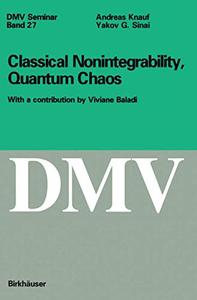Classical Nonintegrability, Quantum Chaos by Andreas Knauf , Yakov G. Sinai , Viviane Baladi
English | PDF | 1997 | 104 Pages | ISBN : 3764357088 | 7.6 MB
Our DMV Seminar on 'Classical Nonintegrability, Quantum Chaos' intended to introduce students and beginning researchers to the techniques applied in nonin tegrable classical and quantum dynamics. Several of these lectures are collected in this volume. The basic phenomenon of nonlinear dynamics is mixing in phase space, lead ing to a positive dynamical entropy and a loss of information about the initial state. The nonlinear motion in phase space gives rise to a linear action on phase space functions which in the case of iterated maps is given by a so-called transfer operator. Good mixing rates lead to a spectral gap for this operator.
Similar to the use made of the Riemann zeta function in the investigation of the prime numbers, dynamical zeta functions are now being applied in nonlinear dynamics. In Chapter 2 V. Baladi first introduces dynamical zeta functions and transfer operators, illustrating and motivating these notions with a simple one-dimensional dynamical system. Then she presents a commented list of useful references, helping the newcomer to enter smoothly into this fast-developing field of research. Chapter 3 on irregular scattering and Chapter 4 on quantum chaos by A. Knauf deal with solutions of the Hamilton and the Schr6dinger equation. Scatter ing by a potential force tends to be irregular if three or more scattering centres are present, and a typical phenomenon is the occurrence of a Cantor set of bounded orbits. The presence of this set influences those scattering orbits which come close.
Without You And Your Support We Can’t Continue
Thanks For Buying Premium From My Links For Support
Thanks For Buying Premium From My Links For Support



